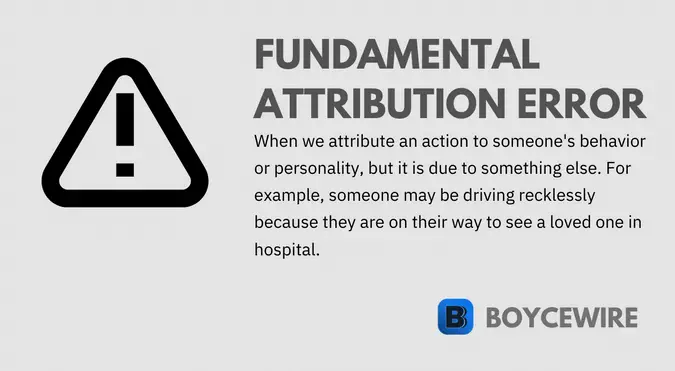Fundamental Attribution Error: (What it is & 3 Examples)

What is the Fundamental Attribution Error
The fundamental attribution error is where we incorrectly attribute a persons actions. For example, when someone cuts us up on the road, we may think its because of their personality. They are simply not a nice person. However, the error occurs when that action is actually attributed to the situation. For instance, that person may be rushing to see a loved one at the hospital rather than maliciously cutting you up.
Key Points
- Fundamental attribution error is where we confuse dispositional attributions with situational attribution or visa versa.
- We often believe peoples actions are as a result of their character, but can be attributed to their situation – which is the most common form of attribution error.
In order to explain the fundamental attribution error, it is important to define what an ‘attribution’ is. Attribution simply refers to how we explain other people’s behavior, or, what we attribute that behavior too.
There are two types of attribution. They are dispositional attribution (internal) and situational attribution (external). The fundamental attribution error occurs when we confuse the cause of an individual’s actions with the wrong attribution. Let us look at these two types below.
Dispositional Attribution
Dispositional attribution is where an individual’s actions are explained by their personality, beliefs, or opinions. In other words, something that is inherently characteristic of that person. For instance, Johnny may always insist on putting his socks on before his pants because it brings him good luck.
Situational Attribution
Situational attribution is where an individual’s actions are explained by their environment, people, or perhaps their circumstances. In other words, their actions are driven by external factors from them as a person. For instance, Jill loses her temper at one of the staff at Walmart. However, she had just been fired which resulted in an emotional reaction.
Fundamental Attribution Error Explained
So we have looked at dispositional and situational attribution, which leads us to the fundamental attribution error. This occurs when we interpret an individual’s actions to be driven by the opposite attribution.
For example, you get cut up whilst driving to work. You may think ‘this guy is a horrible person’, or perhaps something of that nature. We may instinctively think that the drive cut us up because he is an unpleasant person. In other words, a dispositional attribution that lies within his personality, beliefs, or opinions.
This is a far easier conclusion to reach, rather than understanding that it may be because he is driving to see his wife giving birth. So it is a situational attribution that caused reckless driving, not part of his personality.
We call this a fundamental attribution error as we believe that the action is caused by the incorrect attribution. Now, this could also come around the other way. We may think that people act due to their situation, but it is in fact due to their disposition.
With that said, it is far more common for us to believe that actions are driven by a person’s disposition. The reason? Well, it’s far simpler for us to understand that a person does something because they are bad. However, it is much more difficult to comprehend a situation that we have no idea about. If we go back to the reckless driven, for example, it is virtually impossible for us to know his wife was in the hospital giving birth.
Fundamental Attribution Error Examples
Example #1
Susan has an interview with Company ABC at 1pm. She catches the train and when she is getting off, she gets pushed by another passenger who is running for another train. In the process, Susan twists and sprains her ankle. Filled with pain but desire, she hops along as best as she can to get to the interview on time.
When she arrives, she is over 15 minutes late. Fred and Louise who are the interviewees say to each other, ‘she’s late and not very punctual. I don’t know if we can trust her to come to work every day on time’. ‘It must be something in her character’.
Despite having a good interview, Susan doesn’t get the job. Fred and Louise blame the poor punctuality on her character. In other words, they think it’s a distributional attribution. Perhaps she is just a disorganised person, but that wouldn’t fit well into the role.
Yet, the real reason was a situational attribution. She sprained her ankle. A situation she could not have foreseen. In turn, there is a fundamental attribution error.
Example #2
Actors and actresses who play a character on the screen can often be confused with their on-screen character. For instance, Jennifer Aniston may be seen to have the same characteristics as Rachel from Friends.
This can lead to a fundamental attribution error. We may consider Jennifer Aniston and Rachel as one of the same. Her actions may replicate what Rachel would do. However, they are not the same. Jennifer Aniston is merely portraying Rachael in a situational attribution. Those characteristics are part of acting and are limited to that situation.
Many actors and actresses face such issues in real life. They get confused between the human and the character. We may expect an actor or actress who portrays an evil villain to be evil and devious in real life. However, we are attributing that to the actor or actress’s situation by which they are performing, not their dispositional attributes.
Example #3
Let’s say your friend Jake takes you to a party. He introduces you to his other friend Aaron. He seems disinterested and unwilling to talk to you. Aaron is rude, abrupt, and generally unpleasant to be around.
It would be fair to conclude that Aaron is simply not a nice person. You may not see why he is friends with Jake in the first place. ‘Why are you friends with this guy’? You might say.
On the surface, it may seem like Aaron isn’t a nice person. However, what we haven’t seen is the fact that his mother passed away last week and he had just been fired from his job.
What we see is a fundamental attribution error. We may assign his bad behaviour towards his personality, or, dispositional attributes. Yet his behaviour is better explained by his situation instead.
How to Avoid Fundamental Attribution Error
We tend to attribute behaviour to dispositional attributes. In other words, an individual’s character. The reason is simple. We don’t have an idea of the other persons situation and what they are going through. So, what may be a situational attribute, we often blame as that of the persons disposition.
At the same time, it’s important to acknowledge that the opposite can also occur. In other words, a situational attribute can be mistaken for a distortional attribute.
1. Acknowledgment
In order to avoid either of these, it is first important to acknowledge that we make such errors. Once we understand that we are prone to them, we can be pro-active when they occur.
When we get angry at the shopper cutting in, or our boss reprimanding us, it’s important for us to first consider the circumstances by which the situation unfolded. We don’t know what might be going on in their home life, so there may be more to the situation that it seems.
2. Try and Understand
Sometimes it is impossible to understand others’ situation. We cannot know that the driver who just cut you up is in a rush to see their dying father, or the guy who barged past you were in a state after losing his job.
By trying to understand that it is not necessarily the individual’s disposition, we can not only calm ourselves down but also rationalise the situation.
3. Think of the Person not the Action
We can get annoyed at a person’s actions and therefore take the anger out on them. This can be counter-productive, especially when there is a fundamental attribution error.
Related Topics
FAQs on the Fundamental Attribution Error
The Fundamental Attribution Error is when we think someone took an action because of their behaviour. However, the action was taken because of the situation they were in instead. For example, they may have been fired, which caused the negative action to occur. At the same time, the opposite may also occur. In other words, we assume that actions are driven by a situation when they are really driven by a persons disposition.
One such example of the fundamental attribution error might be if you get cut up whilst driving. For instance, you may think they are a horrible human being and there is no excuse to do such. However, we may not know if they are rushing to see a loved one in hospital. So that initial attribution is misplaced and therefore an error of judgement.
We tend to make a fundamental attribution error because we try and justify the actions of others. When someone does something bad, we feel like we have to assign a reason for why it occurred. The most obvious is that of the persons disposition. After all, we cannot know what other situational effects may be at play. We may not know if they have been fired, lost a partner, or their home.
The consequences of the fundamental attribution error can be significant – particularly when looking at close personal relationships. As humans, we have the tendency to think the worse of people. In today’s society, this is often applied through the use of social media. Rather than having an understanding approach, we often assuming that behaviour is an inherent thing rather than something that is emotional driven. For instance, there may be circumstances whereby a loved one gets angry because they are overcome with stress. Perhaps one too many events in the day have caused emotional distress. By wrongly identifying these, relationships often break down.
When it comes to the fundamental attribution error, it’s important to first of all recognise it. By firstly acknowledging it, we are able to become aware of it. We can then look to try and understand the situation better. After all, it’s not always due to a persons specific character. Only then can we get a better understanding of why the situation happened.
About Paul
Paul Boyce is an economics editor with over 10 years experience in the industry. Currently working as a consultant within the financial services sector, Paul is the CEO and chief editor of BoyceWire. He has written publications for FEE, the Mises Institute, and many others.

Further Reading
 Conflict Theory: Definition & Examples - Conflict theory refers to the state of constant conflict which is created by competition for limited resources. It was originally…
Conflict Theory: Definition & Examples - Conflict theory refers to the state of constant conflict which is created by competition for limited resources. It was originally…  Exchange Rate: Definition, Causes, Effects & Types - An exchange rate is the value by which two currencies are swapped with each other.
Exchange Rate: Definition, Causes, Effects & Types - An exchange rate is the value by which two currencies are swapped with each other.  Allocative Efficiency: What it is & Examples - Allocative Efficiency occurs when consumers pay exactly the marginal cost of production. In other words, businesses stop making the product…
Allocative Efficiency: What it is & Examples - Allocative Efficiency occurs when consumers pay exactly the marginal cost of production. In other words, businesses stop making the product… 
